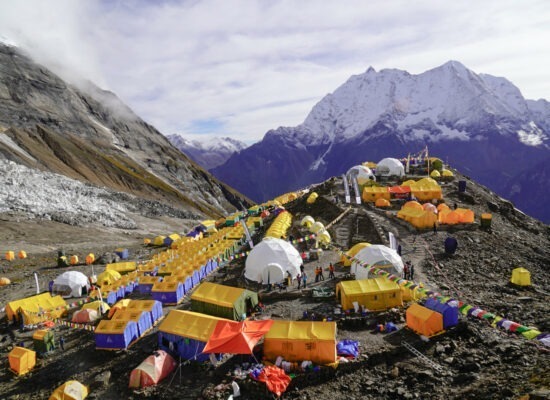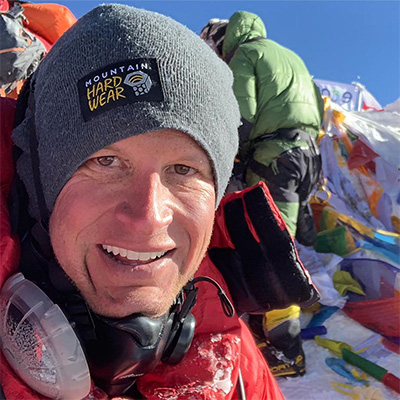
Believe it or not climbers attempting Everest in the spring of 2014 leave home in only 171 days, a little under 6 months. By now they have paid their deposits, are finalizing gear s but most importantly should be in the throes of training.
By the way, the definition of throes is “intense or violent pain and struggle, especially accompanying birth, death, or great change.”
OK then.
There are other aspects to preparing for Everest including developing technical skills, gaining experience at altitude but I’m going to focus on training for this post.
When I was training for Everest, I was told “Alan, you better be in the shape of your life!” Well they almost got it right, actually I needed to not only be in the shape of MY life, I needed to be in Everest Shape.
With the clear disclaimer that I am not a doctor and everyone should visit their own Doc before entering any kind of Everest training program, let’s me provide some thoughts from my experiences.
My personal experiences with Everest have been difficult. I experienced a lung infection that stopped one climb, my body simply refused to acclimatize above 23,000’ on another, and I gave up mentally on my third. The vast majority of Everest climbers have full time jobs, full time families and cannot spend many hours everyday for a year to get in professional shape; so it becomes critical to make every workout count without hurting yourself.
However, you must push yourself beyond your perceived limits to be ready. For my fourth attempt and successful summit on Everest, my training mantra became: When you think you have given it your all, you have just started if you want to summit Everest.
The ‘Best” Method
If you ask 100 Everest climbers you might get 101 different answers on the way to train and I don’t think there is one ‘perfect’ approach. Some climbers will say cycling for 5 to 8 hours in the middle of the night is , others will prefer swimming and then some say weight training will get you there. It is popular today to use CrossFit.
But the common thread to all training is pushing yourself without injury and building mental discipline. There is no doubt that an Everest climb requires mental and physical endurance like few other sports. I consistently observe that competitive marathoners, triathletes and cyclists do well. However, all agree that training the mind is equally important as training the body.
For my first attempts in high-altitude climbing, I mostly ran and lifted weights. I had a full time job that required extensive traveling so I worked out in hotel gyms and ran stairs. While it was good, it was not nearly enough. In hindsight, I simply never developed the stamina needed to climb Everest. My approach failed to develop the micro-muscles used in real worked conditions, finally, it did little for my metal toughness.
I’m not saying running and gym work would not get you in Everest Shape, but it didn’t for me.
Real World Training
What did work for me was real world activity that mimicked what my body would go through on Everest. In preparation for my 2011 climb of the 7 Summits, I spent 2010 climbing. I took a similar approach this year for my successful summit of the 8000m mountain Manaslu.
I am fortunate to live in Colorado, close to 14,000 foot (4000m) mountains aka 14ers. I’ll address alternatives for training in a moment for those living at sea level.
In both 2010 and 2013, I set a goal to climb a 14er each week with a 30-40lb (13-18kg) pack. Also, to do at least two shorter hikes with lighter packs each week. I never ran or lifted weights. I climbed in all types of weather and times of day. These climbs and hikes ranged from 3 to 12 hours in duration.
My goal was to work on my overall body strength, cardio and most importantly my stamina. I would try to climb at a 1500 feet per hour pace. I also worked on my nutrition and hydration being mindful of the time between breaks and what gels and powders worked for me. I found Honey Stinger products and CamelBak tablets worked for me, but everyone is different and has their favorites.

To work on my mental toughness, a traditional problem for me, I would go to my local 14er, Longs Peak, arriving a 1:00AM when the winds were forecast to be high, as in 50 mph (80kph). My goal was to climb as high as I could before getting knocked down by the wind at least three times.
I would put on my full 8000m gear (boots, crampons, down suit, mittens, goggles, etc) plus my pack – the same gear I planned on using on Everest or Manaslu – and pushed hard. I did this in January to be exposed to the coldest temps, highest winds and deepest snow.
In addition to the mental and physical training, I lost weight and cut out alcohol during the training time. I went on these climbs feeling confident both physically and mentally. I knew my body, the signs of fatigue, and when I could go further.
This last point is key. I am convinced I could have gone higher on some climbs where I turned back but didn’t simply because my mind said no. Our bodies are incredibly strong and our reserves deep. However, saying that, it was the right decision on some of these to turn back. What made the difference later was my climbing experience and knowledge of my body.
For both my 2011 7 Summits climbs (including Everest) and my recent Manaslu summit, my body performed significantly better than back in 2002. Obviously I was older, 57 for Manaslu. I did not loose weight on that climb and never felt so fatigued that I wanted to turn around. Thus, I believe I have found the training regime for me.
Stairs and Beaches
So what if you live at sea level or have a full time job that prevents a schedule similar to mine? First, if you have committed the tens of thousands of dollars and time away from work and family, the commitment to training should follow easily. There are many exercises you can do in the gym that simulates real-world movements while climbing. Also, running long distances and intervals build stamina and cardio.
But I strongly believe in outdoor training as it exposes your body and mind to the elements. So if you live near a beach, hiking in the sand for 8 to 12 hours with a 40lb pack is great. If you live in the city, climbing stairs with a pack will build your legs, cardio and metal toughness. If you have a 3,000 foot mountain or hill nearby, do laps on it for hours at a time – with a pack. In all cases, taking a midnight run or ride, in the cold rain will pay dividends when you are on the Lhotse Face in a driving windstorm.
Commitment
But above all, fully commit yourself to your training. A mistake I made early on was quitting too soon. As I said, when you are dead tired, your training has just begun. By the way, I believe my approach for Everest also applies to Rainier, raising a child or finding a cure for Alzheimer’s. When it gets tough, you have just started.
Please visit this link to read more on my training experiences and ideas.
What works for you?
Climb On!
Alan
Memories are Everything




14 thoughts on “Getting in Everest Shape”
fantastic and practical advice Alan. We will work on it,
Hi Alan,
This is a great article for inspiration and motivation. Your writing will help me in my 2014’s Kili and Rainier climbs.
Thanks for sharing your thoughts.
This is good motivation for upcoming climbs. I find that living at sealevel you are at a disadvantage than someone like yourself that lives all the time around mountains. I have to train even harder than you and not underestimate any climbs, especially high altitude ones. Thanks for posting.
Hi Alan good to read your article again! And as always you are motivational, inspirational and informative! My training for my 2017 climb has begun with Tim Mosedale. Currently it involves rock climbing in The Lake District, and winter mountain training in the Cairgorms in Scotland. Tim is a great believer like yourself in outdoors training on dales and fells,where you start building core and ankle muscles in uneven surface. In fact i move to Leicestershire in January so that I can spend more time outdoors,which is difficult in London. So everest has in fact prompted a complete change in City and career for me at 50!! Keep writing Sir,you are an inspiration!!
Nice plan Divyesh.You are in good hands with Tim.
Great read as always Alan. I failed on Everest this year because like you, I failed to understand the difference between being in shape and being in Everest Shape. I’m going back in the spring and my current workout schedule is significantly more strenuous than last time. Two hours every morning strength training and 2-3 hours of cardio or endurance training every afternoon (with two rest days). Plus, I am making a point of getting out to Colorado once a month to get in some climbing at a higher altitude. Hopefully I will not only be in better shape this time but the hard work will give me the confidence needed to be successful.
Thanks Kent. Sounds like you have a great program going. By the way, I never think of not summit as a failure, I call them “non-summits” But seriously, a failure is only when you try something hard and don’t learn anything from the experience. Clearly you did not fail or will this next time. Best of luck!
Kent I wish you all the best and look forward to following your progress via Alan’s blog 🙂
Great read and advice. 🙂
Excellent article, Alan. For those of us without such lofty (pun intended!) goals, the analogy is not lost: “But the common thread to all training is pushing yourself without injury and building mental discipline.” I hope you & Chris Mullen will forgive me for the hashtag, but #inspiration!
Looks a whole lot safer there than in the middle of the Khumbu ice fall. 😉
You got that right Mark!!
Thanks for sharing, Alan. Great perspective.
Boy, did I need to read this today.
Comments are closed.